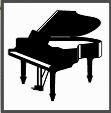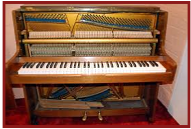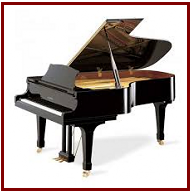




Richard W. Bushey - Piano Tuner/Technician
1694 N. State Hwy 125, Strafford, Mo. 65757
(417) 294-3377 - mobile or (417) 831-0749
(417) 294-3377 - mobile or (417) 831-0749
Associate Member of the
Piano Technician's Guild
Piano Technician's Guild
"make a joyful noise..."
Home
Rates
Services
- Tuning
- Repairs
- Regulation
- Voicing
- Cleaning
- Key Rebushing
- Reconditioning/
Rebuilding
- Refinishing
- Moving
FAQs
Used Pianos
Helpful Links
Piano Care
- General Piano Care
- Humidity Control
Piano Accessories
- Accessories/Gifts
- Grand String Covers
My Blog
Satisfied Customers
About Us
Contact Us
(Non-Smoker!)
Locally Licensed
and Insured
and Insured
Mulitiple piano discount (same location only)
Action Reconditioning
Piano Regulation
Piano Repairs
Piano Tuning
Quality, Friendly Service
What I Offer

Piano Care








COVID-19 Sanitizing Piano Keytops

Per Steinway and Sons website..."over-the-counter Hydrogen Peroxide available from any pharmacy, is safe for piano keys. Dampen a cotton pad with Hydrogen Peroxide and use the pad to wipe down the piano keytops (back to front) between players.
Use diluted alcohol-based disinfectants, do not use bleach-based disinfectants or any product containing citrus.
If using a spray or liquid bottle, use disposable pads or soft cloths. Put the disinfectant on the towel and not on the piano.
Always follow up with a dry towel and never leave any liquids on the piano or keys."
Use diluted alcohol-based disinfectants, do not use bleach-based disinfectants or any product containing citrus.
If using a spray or liquid bottle, use disposable pads or soft cloths. Put the disinfectant on the towel and not on the piano.
Always follow up with a dry towel and never leave any liquids on the piano or keys."

So, how DO you care for your piano? What kinds of things CAN you do, and what kinds of things should you leave for your technician to do?
Well, here are some quick pointers from my years of experience.1) Keep your piano in good repair. Parts wear and can break over time. They also can go out of adjustment as the felts compact and wear. Have your technician inspect your piano for stray pencils, coins, etc. which can jam up the works and cause broken parts. If you have notes that don't work well, don't keep playing it, get it repaired. As with most repairs, the longer you wait, the more costly those repairs can become. Have your technician regulate your action every several years or so to keep your action working like it should.
2) Keep your piano regularly tuned. It is recommended to have your piano technician tune your piano about 1-2 times/yr. Humidity swings cause the dimension of the wood and felt parts in the piano to change shape (expanding and contracting with seasonal changes) which cause the piano to go sharp or flat of standard pitch (A=440). Again, the longer you wait, the more the piano will go out of tune, and the more expensive and time consuming it is to bring the piano back to standard pitch.
3) Keep your piano in as stable of an environment as possible. Humidity changes not only affect the tuning of the instrument from day to day, but it can also affect how many repairs you have to make on your instrument throughout its life. High humidity can cause sticky keys as wood swells. Low humidity can cause wood to crack (pinblock, bridges, keys, flanges, etc.) as well as glue joints to dry out and fail. If you don't have a stable environment, consider having a Dampp-Chaser system
installed on your piano.
4) Keep your piano out of direct sunlight. While it is not as important now days as it used to be to keep your piano on an inside wall due to better insulated walls than in the past, it is still a good idea to keep your piano out of direct sunlight. Sunlight will fade the finish of your piano, as well as cause excess heat on the piano which should be avoided if at all possible.
5) Keep food, drinks, and plants you water OFF the piano. Food produces crumbs and all manner of sticky stuff that doesn't belong near a piano. Wash your hands before you play. Cold drinks will sweat and create rings on your piano's finish, not to mention the mess and damage that can occur if it is spilled. If you wouldn't place a drink on your computer....well.....enough said. Potted plants may look nice on your piano now, but down the road you'll wish you hadn't when you see that nasty ring it leaves behind.
6) Keep your piano clean, inside and out. The inside of your piano can be cleaned out by your technician if you ask them. Every 10 yrs, or so, it is a good idea to have piano thoroughly cleaned inside and out (Including the keys being removed and vacuumed under them. They collect a multitude of dust, lint, coins, paper clips, and other small items).
UPRIGHTS:
a) Pedal trap area - If you care to, you may remove the bottom board on uprights (above the pedals) and vacuum the bottom of the piano out. There are usually not much you can hurt there. Just be careful.
b) Vacuum action area/above keys - If you feel adventurous, you may lift the lid, remove the music rack portion and key cover, and vacuum the tops of the keys and the front of the action (parts you can easily reach). Use EXTREME CAUTION if you decide to vacuum around the action. The wrong move could cause broken parts pretty quickly that would lead to expensive repairs.
c) Back of piano - You may also safely vacuum the back of an upright as well.
GRANDS:
On a grand, there are a couple things you can safely do
a) Tuning pin area - you may vacuum around the tuning pin area. Using a toothbrush may help loosen the dirt around the tuning pins and strings. Do not use cleaning products, solvents, or lubricants of any kind around the tuning pins unless you plan to rebuild or throw your piano away!
b) Damper Heads - You can wipe the wood damper heads with a soft, slightly damp cloth (if necessary) using VERY CAREFUL front to back strokes and very little downward pressure. Use no side to side motion on them at all. One word of caution here...if the dampers are bumped, even slightly, there is a possibility that that note may not dampen correctly, so if you choose to clean dusty damper heads, do so with extreme caution, and at your own risk.
c) Soundboard - If you would like to dust the soundboard on a grand, your technician may have a tool to do that, or you can possibly purchase a soundboard cleaner from your technician and do that yourself.
UPRIGHTS and GRANDS:
a ) Keytops - You may use a soft damp cloth to clean your keytop (whites and blacks). A little warm water with a very small amount of mild dish soap can be used if water alone won't clean them. Slightly dampen cloth only. Do not drip water down between the keys. I have also used baby wipes with very good success. Alchohol based wipes may be OK if used sparingly, but nothing with bleach. Extended use of wipes with Alcohol in them tends to dry the key tops out and they may develop cracks. Per Steinway.com website, over-the-counter Hydrogen Peroxide on cotton ball may also be used to SANITIZE the keys. Also, be careful not to scrub too hard on some types of black sharps as you may rub the black finish off and it will look uneven. It's a good idea to clean sharps and naturals with different wipes so as not to get any potential black stain from the sharps on your white keys.This is not an issue with plastic sharps. You might also consider purchasing KeyBrite. It is a Cory product that has been specifically designed for cleaning piano keytops. You will be able to do an adequate job with the keys left in the piano if they aren't too grundgy, however, if they are pretty dirty your technician can remove the keys to allow the keys to be more easily and thoroughly cleaned.
b) Action - I would never recommend that a customer remove a piano action unless they have been properly trained to do so. It can be done, and you may get lucky, but the chances to break something in the process is pretty high. Even a technician who has been removing and replacing actions for many years still has to be super careful not to snag a damper on the action bolts, in an upright, or not to press A0 and C88 keys while removing a grand action, and inadvertently snapping off those hammers. Your technician can, however, remove the action for a thorough cleaning. This usually involves carefully blowing the action out with compressed air (outdoors, of course). Your technician can inspect the action, make any necessary repairs, or take it to the shop for action reconditioning if needed.
7) Keep the case cleaned and/or polished. There is much debate about the proper way to care for the various finishes on pianos. There are many products on the market and things to consider, so I will not attempt to describe in detail here how to maintain your finish, for there are those who know much more than I do in this area. The PTG website has put together some good, detailed information on how to care for your piano's finish.
A couple basic things to keep in mind is that dust scratches...so be careful what type of cloth you use to remove the dust...microfiber cloths are best. Also, feather dusters, although good, can easily scratch high gloss finishes, so be cautious with their use. Most pianos rarely need to be polished, so use them sparingly to avoid build up and avoid spray polishes altogether as they can contain oils that get airborne and can find their way into the pinblock of the piano. If you do use them, spray them directly on the cloth, well away from the piano, not directly on the piano.
According to the PTG website, "new piano finishes generally require only occasional cleaning with either a dry or damp cotton cloth. Older piano finishes may benefit from an occasional polishing with a good quality polish, but frequent polishing is not recommended. The PTG technical bulletin on piano finish care discusses this subject in detail".
Regular Tuning Rate:$150
(See rates page for more details)
(See rates page for more details)





Links to Piano Technician's Guild of America pages:
Other sites with helpful piano information:
How Often Should My Piano Be Serviced?
The Special Care and Maintenance of the Teaching Piano
How Should I Take Care of My Piano?
Basic Rules of Piano Care
Tips on Buying a Piano "you generally get what you pay for". John Ruskin is quoted as saying "there is hardly anything someone cannot make a little cheaper, and sell for a little less money - and the person who considers price only is this man's lawful prey".
The Special Care and Maintenance of the Teaching Piano
How Should I Take Care of My Piano?
Basic Rules of Piano Care
Tips on Buying a Piano "you generally get what you pay for". John Ruskin is quoted as saying "there is hardly anything someone cannot make a little cheaper, and sell for a little less money - and the person who considers price only is this man's lawful prey".
Copyright 2024 Richard W. Bushey







